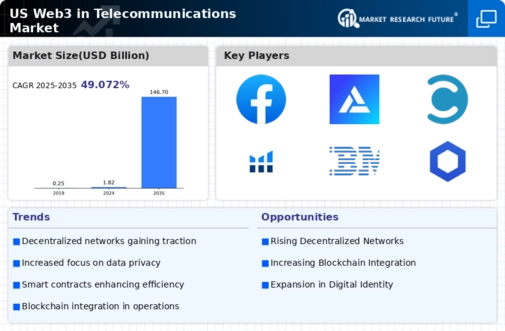The web3 in-telecommunications market is currently characterized by a dynamic competitive landscape, driven by rapid technological advancements and an increasing demand for decentralized communication solutions. Key players such as Helium (US), Filecoin (US), and Chainlink (US) are strategically positioning themselves to leverage the potential of blockchain technology in telecommunications. Helium (US), for instance, focuses on creating a decentralized wireless network, which appears to be gaining traction among users seeking cost-effective connectivity solutions. Meanwhile, Filecoin (US) emphasizes data storage and retrieval, which is becoming increasingly relevant as data consumption continues to surge. Chainlink (US) is enhancing its smart contract capabilities, thereby facilitating more secure and efficient transactions within the telecommunications sector. Collectively, these strategies are shaping a competitive environment that is increasingly focused on innovation and user-centric solutions.
In terms of business tactics, companies are adopting various approaches to optimize their operations. For example, localizing manufacturing and enhancing supply chain efficiency are becoming critical as firms seek to reduce costs and improve service delivery. The market structure appears moderately fragmented, with several players vying for market share, yet the influence of major companies is significant. This competitive structure fosters an environment where innovation is paramount, as companies strive to differentiate themselves through unique offerings and enhanced customer experiences.
In October 2025, Helium (US) announced a partnership with a leading telecommunications provider to expand its decentralized network infrastructure. This strategic move is likely to enhance Helium's market presence and provide users with more reliable connectivity options. The partnership underscores the growing recognition of decentralized networks as viable alternatives to traditional telecommunications solutions, potentially reshaping user expectations and industry standards.
In September 2025, Filecoin (US) launched a new initiative aimed at integrating its storage solutions with existing telecommunications frameworks. This initiative is expected to streamline data management processes for telecom operators, thereby enhancing operational efficiency. By aligning its offerings with the needs of telecommunications providers, Filecoin is positioning itself as a critical player in the evolving landscape of data storage and management.
In August 2025, Chainlink (US) introduced a new protocol designed to enhance the interoperability of smart contracts across different blockchain networks. This development is particularly significant as it facilitates seamless communication between various decentralized applications, which could lead to more robust telecommunications solutions. The ability to integrate diverse systems is likely to attract more users to Chainlink's platform, further solidifying its competitive edge.
As of November 2025, current trends in the web3 in-telecommunications market are increasingly defined by digitalization, sustainability, and the integration of artificial intelligence (AI). Strategic alliances among key players are shaping the competitive landscape, fostering innovation and collaboration. Looking ahead, it appears that competitive differentiation will evolve from traditional price-based strategies to a focus on technological innovation, enhanced user experiences, and supply chain reliability. This shift suggests that companies that prioritize these aspects may gain a substantial advantage in the rapidly changing market.






















Leave a Comment